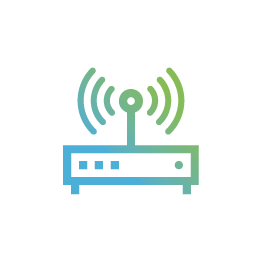Wi-Fi

Home/Office WiFi
All IT equipment is designed to a budget; the router we supply is suitable for most normal sized houses, but will struggle with larger or more demanding environments. As the maximum Wi-Fi signal strength is limited by UK regulations, even a very high priced router may not cover every room in a property. This is especially so if the walls are thick stone, or newer foil lined plasterboard.
Our general advice when installing our service, is to locate the router as close to the point where it’s going to be used most heavily – which in a residential property is normally the living room or where you have the TV.
To extend the WiFi coverage around your house further needs some planning and probably investment.
The options in order of cost are:
Range Extenders
These are almost certainly the cheapest but should really be avoided if at all possible. While the may extend the range, they massively impact the performance of the network and are probably the number 1 cause of ‘slow wifi’ complaints we receive.
They just re-broadcast the WiFi signal they receive – which if you think about radio like a walkie-talkie, it means you have someone in the middle just duplicating everything anyone says. Yes they extend the range, but while the repeater is re-transmitting your data, nothing else can use the WiFi.
Power Line Extenders
Similar to the range extenders in that you can readily pick them up from supermarkets or on online retaillers etc, and are pretty much plug and play. One unit is located next to your router and is connected to it via a network cable. The other units are spread around the house, extending the WiFi coverage. Instead of using radio channels, they use the mains wiring to transmit the signals back to the router.
They normally ‘just work’, however we have seen issues with very old wiring in houses, and also in large houses that have multiple fuse boards and/or phases. They are also very flexible – if you need to improve WiFi around the house depending on who is staying or using bits of the house, just move the extender into a socket in the appropriate room.
Mesh Systems
Like the power line extenders, but use a completely separate radio channel to get the signal back to the router. Again, they come as a ‘multi pack’; one of which you connect to the router, the others you then spread around the house. In many cases, it’s usually recommended to switch off the WiFi on our router and let the mesh boxes deal with it. Depending on your house, you may need a few or you may need lots – it all depends on how well the radio signals go through your walls. Still suitable for installing yourself, although some idea of IT is advisable!
Debatable whether Mesh systems are actually cheaper than the next option of wired access points, but it does depend on the system you are looking at – some of the ones we have seen are certainly not cheap.
Mesh is the system SkyQ use to move their data around from box to box. Make sure you read the FAQ entry for that, as trying to run your own ‘mesh’ alongside Sky is likely to be painful.
Wired Access Points
Install extra WiFi access points around your house, but use network cabling to get the data back to your router. Without question the best and most reliable way to extend the coverage in your house. Access points can vary in price & quality, but the main thing here, is that it involves extra cabling. If you are happy to run the cables yourself, that helps keep the costs down.
This is what we use in our homes, but can often be the most expensive option.
Examples of access points we use: UniFi AC-LR, UniFi Mesh, Audience
If you need help with setting up Wi-Fi around your house contact our team who can advise on booster plugs or do a bespoke system within your house. Please ask for prices as each property will require different equipment and time to set this up.